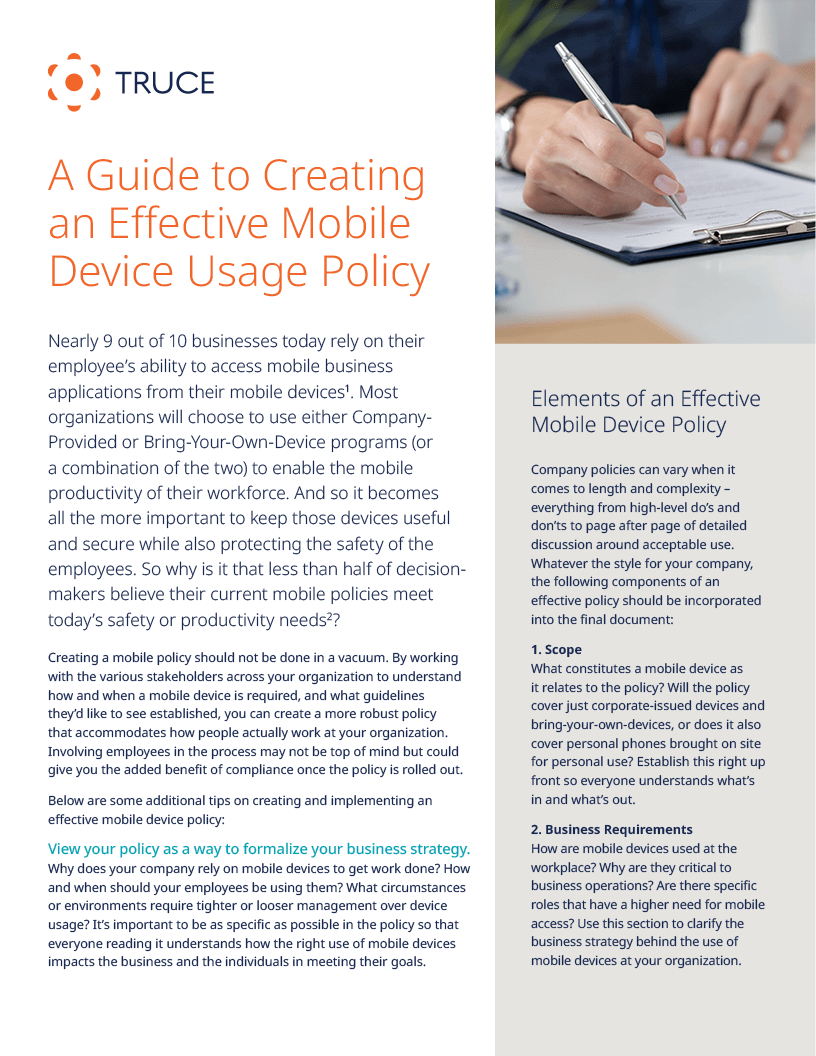Key takeaways:
- Corporate mobile device policies should empower, not limit, employees
- Policy should focus on productivity, not just control
- Engage interdepartmental teams and consider the context of a business and its workers’ roles to strategically limit the usage of mobile devices while encouraging productivity and frictionless communications for deskless workers.
As mobile technologies have become more deeply ingrained in our everyday lives, we increasingly hear from armchair psychologists about the level of distraction our devices bring with them. Texts, email, social media, games – more than just idle time wasters, these features are regarded as productivity killers and, under certain circumstances, even dangerous in a real-life sense.
Yet this is the very same technology that has been designed to create efficiencies in our workflow, streamline systems and keep us connected to colleagues. It’s too useful to be broadly restricted in a way that leads to under-use. Corporate mobile device policies should be implemented to protect both the employee and company – but always with empowerment in mind. Companies that take a short-sighted or misguided approach, following a “no first” policy, tend to foster the opposite effect.

A Guide to Creating an Effective Mobile Device Usage Policy
Learn the components of an effective policy
Just look around the office or plant floor to identify whether your company’s mobile device strategy amounts to a no-first policy. Are your employees so afraid to glance at their work phones that they’re bringing in alternative devices because the policy is specific to work devices? Thumb through the corporate handbook. Does it outline harsh punishments for device use (beyond those that present a safety risk)? Is the prevailing culture one that discourages engagement with devices to the point that policy harms productivity?
At least when your company’s policy is clear, workers know precisely where they stand. But what if those employees are receiving mixed signals from management and leadership? There may be a policy on the books that prohibits the use of a mobile device while driving, for instance, but what if supervisors or dispatchers routinely call drivers on the road? The same question stands for employees who are instructed to limit their device usage in high-risk areas, yet receive constant check-ins from management via text, email or calls. Whether employees are left to interpret that policy doesn’t matter or that it only matters for rank-and-file workers, the message they receive is one leadership won’t want to send.
These policies also lead to the implementation of reactive safety measures: cameras in fleet vehicles intended to reduce distracted driving, for example, or the bricking of devices to prevent theft and data breaches. These methods not only require additional investment and man-hours, but they also lead to employee trust issues and a company culture of constantly looking over one’s shoulder.
How, then, does a company nip a no-first approach in the bud? Shifting in the direction of mobile-device empowerment is a good place to start. Get front-line employees involved in the outlining of company policy, which should be written collaboratively. Interdepartmental teams should all have a hand in drafting a mobile approach, reducing the chances of gaps in policy and building good faith across a company.
Policies should focus on productivity, not just control. The psychology of an Orwellian workplace – one that constantly surveilled its employees and betrays suspiciousness of its labor force at every turn – will make attracting and retaining good talent more difficult. Plus, mobile devices are meant to improve employee productivity, helping workers accomplish tasks. Employees shouldn’t be made to treat one of their best tools as a sort of contraband.
Empowerment doesn’t mean compromising on enforcement. With mobility management software and a rational mobile device policy that takes into account the context of a business and its workers’ roles, companies can strategically limit the usage of mobile devices while encouraging productivity and creating frictionless communications between deskless workers. Implementing a solution like Contextual Mobility Management can dynamically and automatically adapt access to distracting apps or functions in high-risk situations, such as driving, resulting in a proactive approach to safety that allows for simple, democratic, and judgment-free enforcement.
Business leaders should consider how to empower their workers’ device usage, rather than restricting it. By taking a “yes first” approach to mobile device policy policy, companies can create safer, more trustful work environments and avoid the risk of lost productivity or reacting too late to the danger of mobile-device distractions. Need help shaping that policy? Check out the Guide to Creating an Effective Mobile Device Usage Policy eBook to learn the components of an effective policy – and tips on implementing one.

